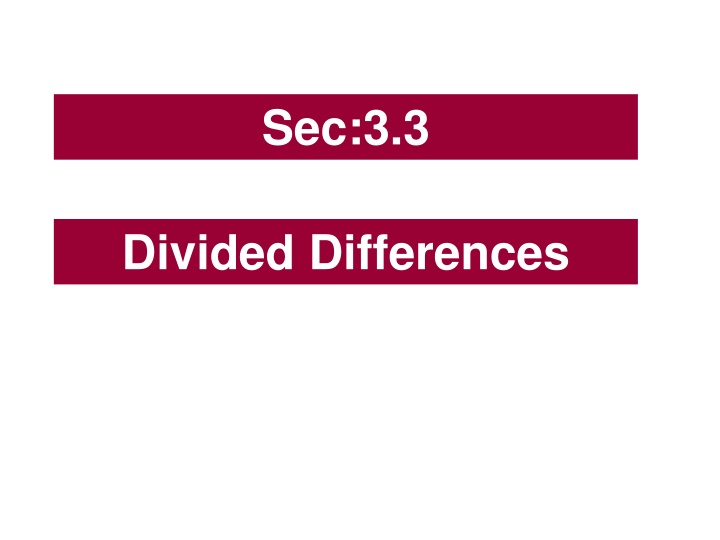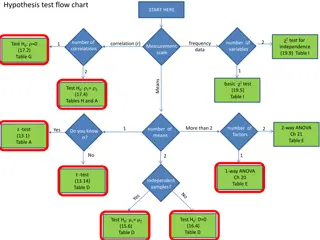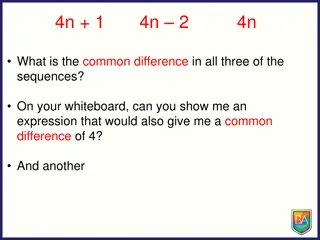
Divided Differences in Polynomial Interpolation
Learn about divided differences, polynomial interpolation, and the unique nth-order polynomial that fits n+1 data points. Explore Divided-Difference Notation and how to compute first and second divided differences in various examples.
Download Presentation

Please find below an Image/Link to download the presentation.
The content on the website is provided AS IS for your information and personal use only. It may not be sold, licensed, or shared on other websites without obtaining consent from the author. If you encounter any issues during the download, it is possible that the publisher has removed the file from their server.
You are allowed to download the files provided on this website for personal or commercial use, subject to the condition that they are used lawfully. All files are the property of their respective owners.
The content on the website is provided AS IS for your information and personal use only. It may not be sold, licensed, or shared on other websites without obtaining consent from the author.
E N D
Presentation Transcript
Sec:3.3 Divided Differences
Sec:3.3 Divided Differences How many lines passes through these two points ? How many parabola passes through these three points ? How many polynomial of degree one passes through these two points ? How many polynomial of degree two passes through these three points ? there is one and only one polynomial of order n that passes through all the points. Polynomial interpolation consists of determining the unique nth-order polynomial that fits n + 1 data points. How many polynomial of degree n passes through these (n+1) points ?
Sec:3.3 Divided Differences Although this polynomial is unique, there are alternate algebraic representations that are useful in certain situations. Lagrange interpolating polynomial Divided-Difference Notation ? ? ? = ?(??)??,?? first divided difference zeroth divided difference ?=0 ?(?) is nth order polynomial that passes exactly through all n + 1 data points (?0,?(?0)), ,(??,?(??)) ? ?0 = ?(?0) ?[??,??] =?[?1] ?[?0] ?1 ?0 ? ?1 = ?(?1) ?[??,??+?] =?[??+1] ?[??] ??+1 ?? ? ?? = ?(??) Example Compute first divided difference ? ?0,?1 and ? ?1,?2 ? ?0=1 ?1=2 ?2=4 ?[?] ?[?0] =1 ?[?1] =8 ? ?2 = 14 ? ? ? =8 1 2 1 ?0=1 ?1=2 ?2=4 ? ?0=1 ? ?1=8 ? ?2=14 = 7 ? ?0,?1 =14 8 4 2 ? ?1,?2 = 3
Sec:3.3 Divided Differences Divided-Difference Notation second divided difference zeroth divided difference first divided difference ?[??,??,??] =?[??,??] ?[??,??] ?? ?? ?[??,??] =?[?1] ?[?0] ? ?0 = ?(?0) ?1 ?0 ? ?1 = ?(?1) ?[??,??+?,??+?] =?[??+?,??+?] ?[??,??+?] ??+? ?? ?[??,??+?] =?[??+1] ?[??] ? ?? = ?(??) ??+1 ?? Example Compute first divided difference ? ?0,?1,,?2 first divided difference second divided difference ? ?[?] ?0=1 ?[?0] =1 ? ?0,?1 =8 1 2 1= 7 ? ??,??,??=? ??,?? ? ??,?? =? ? ? ?= ? ?1=2 ?[?1] =8 ?? ?? ? ? ?1,?2 =14 8 4 2= 3 ?2=4 ? ?2 = 14
Sec:3.3 Divided Differences Divided-Difference Notation second divided difference zeroth divided difference first divided difference ?[??,??,??] =?[??,??] ?[??,??] ?? ?? ?[??,??] =?[?1] ?[?0] ? ?0 = ?(?0) ?1 ?0 ? ?1 = ?(?1) ?[??,??+?,??+?] =?[??+?,??+?] ?[??,??+?] ??+? ?? ?[??,??+?] =?[??+1] ?[??] ? ?? = ?(??) ??+1 ?? K-th divided difference (K-1)-th divided difference ?[??,??+?, ,??+?] =?[??+?, ,??+?] ?[??, ,??+? ?] ??+? ?? divided differences are defined recursively
Sec:3.3 Divided Differences n-th divided difference ?[??,??, ,??] =?[??, ,??] ?[??, ,?? ?] ?? ?? divided differences are defined recursively
Sec:3.3 Divided Differences n-th divided difference ?[??,??, ,??] =?[??, ,??] ?[??, ,?? ?] ?? ?? Example Compute the third divided difference ? ?0,?1,?2,?3 First Second Third ?? ?[??] 1 3 6 3 2 1 13 3 3 1 = 3 = 5 2 6 19 6 3 2 9 5 5 1= 1 = 13 3 19 40 13 5 2 = 9 99 19 5 3 5 99 = 40 ? ?0,?1,?2,?3 = ? 1,2,3,5 = 1
Sec:3.3 Divided Differences A polynomial of order 2 that passes through the three points (?0,?(?0)), (?1,?(?1)), (?2,?(?2)). ?2? = ?[??] + ?[??,??] ? ?0 + ?[??,??,??] ? ?0 ? ?1
Sec:3.3 Divided Differences Example ? ?[?] Fit a second-order polynomial to the three points ?0=1 ?[?0] =1 ?1=2 ?[?1] =8 ?2=4 ? ?2 = 14 first divided difference second divided difference ? ?[?] ?0=1 ?[?0] =1 ? ?0,?1 =8 1 2 1= 7 ? ??,??,??=? ??,?? ? ??,?? =? ? ? ?= ? ?1=2 ?[?1] =8 ?? ?? ? ? ?1,?2 =14 8 4 2= 3 ?2=4 ? ?2 = 14 ?2? = ?[??] + ?[??,??] ? ?0 + ?[??,??,??] ? ?0 ? ?1 ?2? = ? + ? ? 1 ? ?? 1 ? 2
Sec:3.3 Divided Differences General Form of Newton s Interpolating Polynomials A polynomial of order n that passes through the (n+1) points (?0,?(?0)), (?1,?(?1)), ,(??,?(??)). ??? = ?[??] + ?[??,??] ? ?0 + ?[??,??,??] ? ?0 ? ?1 + + ?[??,??, ,??] ? ?0 ? ?1 ? ?? 1 ??does not appear in the product
Sec:3.3 Divided Differences Example ?? ?(??) 1 3 2 6 3 19 5 99 Calculate f (4) using Newton s interpolating polynomials of order 3. Given the data First Second Third ?? ?[??] 1 3 ? 2 6 ? ?? 3 19 ? ? 5 99 ?? ??? = ? + ? ? ? + ? ? ? ? ? + ?(? ?)(? ?)(? ?) The coefficients of the Newton forward divided- difference form of the interpolating polynomial are along the diagonal in the table. ??? = ??
Sec:3.3 Divided Differences Example x 1.0 0.7651977 1.3 0.6200860 1.6 0.4554022 1.9 0.2818186 2.2 0.1103623 f (x) Complete the divided difference table for the data given in the adjacent Table and construct the interpolating polynomial that uses all this data. First Second Third Fourth 0 1.0 0.4837057 0.7651977 0.1087339 1 1.3 0.6200860 0.0658784 0.5489460 0.0018251 2 1.6 0.4554022 0.0494433 0.5786120 3 1.9 0.2818186 0.0680685 0.5715210 0.0118183 4 2.2 0.1103623 ??(?) = ?.??????? ?.??????? ? ?.? ?.??????? ? ?.? ? ?.? + ?.??????? ? ?.? ? ?.? ? ?.? + ?.???????(? ?.?)(? ?.?)(? ?.?)(? ?.?) The coefficients of the Newton forward divided-difference form of the interpolating polynomial are along the diagonal in the table.
Sec:3.3 Divided Differences 4th First Second Third ?? ?[??] 1 3 ? 2 6 ? ?? 3 19 ? ? 5 99 ?? 7 291 ??? = ? + ? ? ? + ? ? ? ? ? + ?(? ?)(? ?)(? ?) 1st 3 2ed 3ed 4th ?? 1 2 ?[??] 3 6 Remark 5 13 If poly of degree 4 is needed, then just complete the diagonal . 1 0 3 5 7 19 99 291 9 40 1 14 96
Sec:3.3 Divided Differences First Second Third ?? ?[??] 1 3 ? 2 6 ? ?? 3 19 ? ? 5 99 ?? ??? = ? + ? ? ? + ? ? ? ? ? + ?(? ?)(? ?)(? ?) Remark Remark The poly of degree 2 which passes through the first three points (1, 3), (2, 6), (3, 19) The poly of degree 1 which passes through the first two points (1, 3), (2, 6) ??? = ? + ? ? ? + ?(? ?)(? ?) ??? = ? + ?(? ?)
Sec:3.3 Divided Differences Example ?? ?(??) 1 3 2 6 3 19 5 99 Calculate f (4) using Newton s interpolating polynomials of order 1 ,2, 3. Given the data First Second Third ?? ?[??] 1 3 ? 2 6 ? ?? 3 19 ? ? 5 99 ?? ??? = ? + ?(? ?) ??? = ?? ??? = ? + ? ? ? + ?(? ?)(? ?) ??? = ?? ??? = ? + ? ? ? + ? ? ? ? ? + (? ?)(? ?)(? ?) ??? = ??
Sec:3.3 Divided Differences data=[1.0 0.7651977; 1.3 0.6200860; 1.6 0.4554022; 1.9 0.2818186; 2.2 0.1103623]; function [d]=Divided_diff(x,y) d=y; n=length(x); for j=2:n for k=n:-1:j d(k)=(d(k)-d(k-1))/(x(k)-x(k-j+1)); end end x =data(:,1); y=data(:,2); [d]=Divided_diff(x,y); d First Second Third Fourth 0 1.0 0.4837057 0.7651977 0.1087339 1 1.3 0.6200860 0.0658784 0.5489460 0.0018251 2 1.6 0.4554022 0.0494433 0.5786120 3 1.9 0.2818186 0.0680685 0.5715210 0.0118183 4 2.2 0.1103623
Sec:3.3 Divided Differences Example ?? ?(??) 1 3 2 6 3 19 5 99 7 291 Write the Newton s interpolating polynomials of order 4. Given the data 1st 3 2ed 3ed 4th ?? 1 2 ?[??] 3 6 5 13 1 0 3 5 7 19 99 291 9 40 1 14 96
Sec:3.3 Divided Differences Example x=[8 9 11 12]; y=log10(x); 0.9031 0.0512 -0.0025 0.0001 Fit a third-order Newton s interpolating polynomial to estimate log(10) using the data at x = 8, 9, 11 and 12. Compute the true percent relative error. [d]=Divided_diff(x,y); d [yi] = eval_poly(x,d,10) Rel_err = (yi-1)/1*100 function [yi] = eval_poly(x,d,xi) yi = d(1); prod = 1; n = length(d); for k=1:n-1 prod=prod*(xi-x(k)) yi=yi+d(k+1)*prod; end ?? ?(??) 8 9 11 12 0.9031 0.9542 1.0414 1.0792 ??(?) = 0.9031+0.0512 ? ? 0.0025 ? ? ? ? + 0.0001 ? ? ? ? (? ??) ??(??) = 1.000044924225105 True percent relative error = 0.0045%
Sec:3.3 Divided Differences Example x=[0 pi/2 pi 3*pi/2 2*pi]; y=sin(x); [d]=Divided_diff(x,y); xx=[0:0.1:2*pi]; [yy] = eval_poly(x,d,xx); ezplot('sin(x)',[0,2*pi]); grid on; hold on plot(xx,yy); plot(x,y,'k*'); hold off Fit a 4th-order Newton s interpolating polynomial to approximate sin(x) using the data at x = 0, pi/2, pi, 3*pi/2 and 2*pi. Plot sin(x) and ?4(?). ? = ???(?) ??(?)
Sec:3.3 Divided Differences Errors of Newton s Interpolating Polynomials ??? = ? ??+ ? ??,?? ? ?0 + + ?[??, ,??] ? ?0 ? ?? 1 ? ? ??? = ??(?) ??(?) =??+1?(?) ? ?0 ? ?? (? + 1)! Theorem 3.6 ?[??,??] =?[??] ?[??] Suppose that f Cn[a, b] and x0, x1, . . . , xnare distinct numbers in [a, b]. Then a number exists in (a, b) with ?? ?? ?[??,??] = ?(?) for some number between x0 and x1 ?(?)(? ) ?! ? [?0,...,??] = Theorem3.6 generalizes this result.
Sec:3.3 Divided Differences Errors of Newton s Interpolating Polynomials ??? = ? ??+ ? ??,?? ? ?0 + + ?[??, ,??] ? ?0 ? ?? 1 ? ? = ??? + ??(?) ??(?) =??+1?(?) ? ?0 ? ?? (? + 1)! For an nth-order interpolating polynomial, an alternative relationship for the error is ?[??, ,??,?] ? ?0 ? ?? ??(?) = ? = ?[??, ,??,?] ? ?? ?=?
Sec:3.3 Divided Differences Remark ? ??, ,?? = ? ???, ,???? ??, ,?? is any rearrangement of the integers 0, 1, . . . , n
Sec:3.3 Divided Differences ??(?) = ?[?,??, ,??] ? ?0 ? ?? nth-order error is Example Problem 18.2 pp522 ??(?) = 0.9031+0.0512 ? ? 0.0025 ? ? ? ? ??(??) = 1.000343408828085 True error = - 3.434e-04 Fit a second-order Newton s interpolating polynomial to estimate log(10) using the data at x = 8, 9, and 11. Compute the true error. ?? ??(?) = ?[?,??,??,??] ? ??(? ??) ? ?? ??(??) = ?[??,??,?,?] ?? ? (?? ?) ?? ?? ?(??) (*) 8 9 11 12 0.9031 0.9542 1.0414 1.0792 ???? = ?.??????? ?? ? (?? ?) ?? ?? ??(10) = -3.434e-04 Because (*) contains the unknown f (10), it cannot be solved for the error. However, if an additional data point f (?3) is available, (*) can be used to estimate the error, as in x=[8 9 11]; y=log10(x); [d]=Divided_diff(x,y); [yi] = eval_poly(x,d,10) err = yi-1 0.9031 0.0512 -0.0025 ??(??) ?[??,??,?,?] ?? ? (?? ?) ?? ?? ???? ?.??? ? ?? ? (?? ?) ?? ?? ???? -2.985e-04



![❤[PDF]⚡ Civil War Talks: Further Reminiscences of George S. Bernard and His Fel](/thumb/20551/pdf-civil-war-talks-further-reminiscences-of-george-s-bernard-and-his-fel.jpg)




![Property Settlements in Family Law: Case Study of Stamatou & Stamatou [2022] FedCFamC1F 241](/thumb/63303/property-settlements-in-family-law-case-study-of-stamatou-stamatou-2022-fedcfamc1f-241.jpg)













